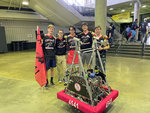Clear, 71°
Wind: mph,




For most people, 4541 is just a random, large number without significance. But to the members of Archbishop Spalding’s robotics team, that number is part of their identity.
Team 4541, also known as the CAVineers, competes annually in the FIRST (For the Inspiration and Recognition of Science and Technology) robotics competition, along with over 3,200 other teams worldwide and 112 within the FIRST Chesapeake District.
The CAVineers were formed 10 years ago by facility member Amy Brunner to give her engineering students a fun extracurricular option. And in that time, the team has grown to include a lot more than just the robotics team.
“We are like a miniature corporation,” Brunner said. “We have a business/marketing team that manages our website, social media, pictures, brand, etc. We have a software team, a hardware team and four separate mechanical robotic teams. All these teams must communicate and work together as one, just as companies do in the professional world.”
Just as they would in the professional world, this team had a challenge to face. Every January, FIRST puts out to all teams a new and unique challenge and the teams have until March, when their first competition is held, to meet it. This year’s challenge was “Rapid React.” Teams had to design a robot to collect and deposit balls into goals, along with making their robot climb an ascending series of overhead rungs as a secondary source of points.
The CAVineers participated in two local competitions and were able to secure a spot in the FIRST Chesapeake District Championships, which were held April 7-9 in Hampton, Virginia. The top 60 teams from the district competed in the championships, with the CAVineers ranking 10th in the group stage before getting knocked out in the first round of the playoffs.
Despite not winning, many members of the team are excited for next year and to rely on what they learned from one another. “Within our team, we have an excellent mentorship system where upperclassmen dedicate a significant amount of time toward training and teaching underclassmen,” said senior Ryan Rich.
Meanwhile, younger members, like sophomore Michael Webb, have learned important lessons that will help them both within the team and in the outside world.
“My teammates have taught me that working on a problem by yourself is hard,” Michael said. "But with the help of the people around you, a solution can always be found.”
And that is what Brunner hopes her students can take away from this team, that it’s OK to not win and that they are able to come together and keep moving forward.
“I want my students to ‘fail forward,’” she stated. “They need to know that in engineering, failure in design is inevitable. No one gets it correct the first time. Instead of giving up and saying, ‘Oh well,’ I want them to analyze, reflect and attack the problem again with a new perspective. I want my students to be comfortable with failure. Dust themselves off and try again. Keep going until they get it right. That’s life.”
Comments
No comments on this item Please log in to comment by clicking here